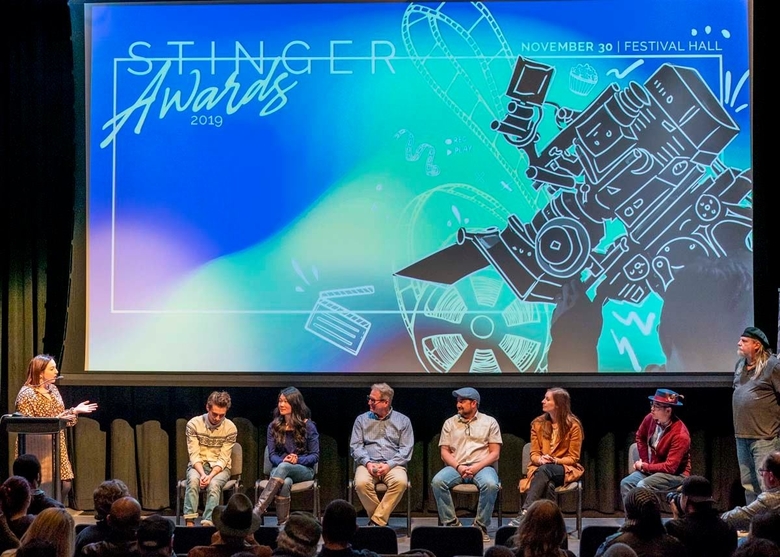Katie Wackett is the Programming and Communications Director of the Calgary Society of Independent Filmmakers (CSIF). During an interview with Wackett, she introduced me to the term “Western filmmakers,” which encompasses the varied group of film practitioners working in Western Canada such as Calgary and Vancouver.
As mostly a demographic term, “Western” also carries with it the connotation of access within Canada’s publicly funded system. In particular, regional centres of Western filmmaking have traditionally been overlooked in funding allocated for the purposes of film and media distribution, which is primarily reserved for productions happening in Toronto and Montréal, Canada’s “media clusters.” To clarify, media clusters are loosely defined as specific cities, sectors, or spaces of concentrated media-related activities that garner innovative and lucrative returns.
It is worthwhile to explore the promotional attributes of “Western filmmaking,” despite its situation outside Canada’s media clusters. In fact, “Western” might cohere to a searchable category designed to increase the discoverability of content made “in the West” of Canada. Using the momentum of the Western genre, could Western filmmaking elevate and then differentiate itself for the purposes of international distribution, catching the attention of federal funding bodies and even global content streamers?
In this interview, Wackett elucidates many key questions related to the advancement of Alberta’s film scene, the operations of CSIF, and what Western filmmakers can offer in their creative pursuits when they receive the support and spotlight they need.
KATIE ARMSTRONG (KA): Tell me more about CSIF, its mandate, how it operates, and whom it serves.
KATIE WACKETT (KW): CSIF primarily serves Western Canadian film communities…It’s really active in Alberta, less so in Saskatchewan, and more so in BC. The mandate of CSIF is to support independent filmmakers, so we program a lot of that work for our members, which is very localized, but the requests I’m getting are "how can I get myself programmed outside this region, how can I get my film to be accepted to festivals in the US, or international festivals..." The requests I get seem to be a lot more on the topics of public relations.
Additionally, we have a great relationship with many artist-run centres in the city [Calgary,] including EMMEDIA, Quickdraw Animation Society, all of the fine art galleries, or even established cultural places like the Glenbow Museum. Also, within Calgary, from a multimedia/arts perspective, everyone is so well connected, even outside of film.
KA: All good things to hear. And tell me a little more about Artifact Small Format Film Festival.
KW: Typically, there’s a really large percentage of international attendees, because small format filmmaking is so niche. There’s not a lot of people doing it within Alberta, and even more in Canada, but you really have to attract an international audience to program a whole festival of these shorts. Often, the international people who attend our festival do so with funding from their countries. We have a lot of people from Latin America, a lot of people from the U.K., the U.S., and Belgium and Germany…They all have a strong presence. We sell out every night…and these people know Artifact, they have a relationship with the festival. So in that aspect, Artifact is a great means of organization, in maintaining these international audiences and maintaining these relationships. There are only a couple festivals in the whole world that exclusively project on small format film.
KA: What workshops have been the most successful with CSIF, or, which ones have been most in demand?
KW: One of the biggest workshops that sells out every time is called “Film Festival Strategies,” where we bring in two programmers who work in Calgary, at the Calgary International Film Festival and the Calgary Underground Film Festival, and they just tell you the best practices for getting into a festival, then what programmers are looking for. Then you get that face-to-face interaction with a programmer as well, so you can say “here’s what my film is, please keep an eye out for it for when it gets submitted.” We also offer just basic filmmaking workshops like on editing […] or “Screenwriting 101.”
KA: Could you speak to some of the biggest challenges facing “Western” filmmakers overall?
KW: One of the main things that arises is being able to get outside of that bubble. We have a lot of filmmakers who do work in Alberta and make features, but they never really see their work outside of that. That’s what I would say is the biggest thing. There’s so much support for them here, so many festivals, so many programming opportunities, but outside of BC and Alberta, it does get shut down a little bit. [In contrast], if you’re a filmmaker in Calgary or an independent filmmaker, everyone knows each other, it’s so small, and it’s very supportive, too.
KA: Would you say “Western filmmakers” are seeking development expertise as well as public relations? Or is it like: “I really just need the distribution assistance, and I’ll tackle development on the next project if need be?”
KW: I would say there’s a need for development overall…The filmmakers themselves often see it as “I need help with distribution.” And it’s not necessarily because the product is not competitive…Our industry [in Calgary] is smaller, so people don’t necessarily have the opportunity to advance their skills on an on-going basis. Because our community is smaller and so supportive, people wouldn’t get that constant constructive criticism they would get in a hyper-competitive industry.
"We’re trying to improve literacy about the industry on logistical terms"
KA: I wanted to shift gears to discuss public funding, and the fact that regardless of public funds available, the “not so secret” reality of independent filmmaking is that you will be funding your first project likely out of your own pocket.
KW: That’s something I speak about all the time at work, as well as balancing that private and public funding. Getting either of those is a struggle, getting funding from outside the province or outside the country [in Calgary] almost seems unattainable.
KA: It’s true. Toronto, for instance, is more centralized and simply closer to the main locations and offices of public funding bodies. Do you ever witness Toronto filmmakers and “Western” filmmakers wanting to work with each other more, but they just can’t due to logistics?
KW: Obviously, there is competition in Ontario, which has a much stronger industry…in terms of funding; Ontario is way, way more active. It’s hard for people out here to break into that Ontario scene and funding. When you’re out here in Calgary, it’s so difficult to get to know filmmakers in Toronto if you’re not there, even getting funding to go to TIFF (Toronto International Film Festival) or to go and meet people physically is a huge thing that would bridge that gap…Filmmaking in general is such a communal thing.
KA: What would you say about the prospect of Western filmmakers travelling to Ontario via public funds, in an ideal world, of course? So, dedicated travel funding?
KW: That’s interesting and tricky. I keep telling filmmakers if you get into a Festival you have to go – it’s part of the process. A lot of them…get accepted into TIFF and…just won’t go or can’t go, can’t afford it…They are missing such an opportunity.
KA: Do you find that filmmakers in Calgary are more interested in getting film festival acceptance rather than selling their content to Los Angeles or Toronto? It seems like the film festival circuit primarily captivates them, is that safe to say?
KW: Definitely…There’s not a lot of talk on securing a distributor, or that kind of stuff…I wonder if it’s connected to not being able to travel and make those connections.…Like if you’re stuck in one place, the easiest way your get your film seen is to send it out on Film Freeway.
KA: That’s so true, the “virtual connection” of Film Freeway. How do you think this is reinforced externally? So for example, how is it reinforced in patterns in production, or even just in public funding allocations?
KW: On a provincial level, the people in charge of our provincial funding are focused on bringing in productions that just want to shoot here…for the landscape. AKA service productions, so they are not necessarily advocating for our filmmakers and for them to get their work seen outside of Alberta. To add to this, our funding [for CSIF] through all levels of government is operational – so that’s just for the CSIF as a non-profit and rentals, workshops. We do offer a non-cash grant where we offer people equipment and facility rentals and stuff like that, but we don’t have any actual funding to provide our members. We are industry partners with Telefilm and ImagineNATIVE. So those are good opportunities for our members to get funding, but we don’t have any of our own.
KA: Would you say that these partnerships are important in that they help “Western” filmmakers in formulating their financial plans for pooling resources that will go towards their productions?
KW: I can say that every season before the Telefilm and ImagieNATIVE applications, we offer an info session where people can meet with mentors and get good advice on their applications, that is something we offer as well as mentorship. So we’re trying to improve literacy about the industry on logistical terms, with less of a formal aspect.
"The media industry is argued to be, above all others, deeply interpersonal and social in nature."
KA: Can you tell me a little more about your partnerships between Calgary Film Centre’s Project Lab and Storyhive?
KW: We work really closely with the Calgary Film Centre, which is underneath Calgary Economic Development. It’s run by the city, and we work really closely with them and their Project Lab. We also work really closely with Storyhive, we see a lot of members applying for Storyhive funding. The Film Centre was originally independent and then they weren’t getting enough shoots, and so the city essentially bought them, and now the city runs it.
KA: Interesting merger, similar things have happened in the City of Toronto and its Office of the Film Commissioner. Do you have any international partners in funding?
KW: We don’t currently have any but I would love to work on that...I would say that working at a non-profit gives you little time to work on those kinds of things or develop that when you have so many things to deal with that are immediate...We’re already operating way outside what our staff [bandwidth].
KA: Fair enough, but you’re still doing a great job. I wanted to end with a broader, more forward-looking question. What sorts of things do you think you can do in the near future to improve the coverage and effectiveness of CSIF as it serves independent “Western” filmmakers?
KW: I would say right off the bat some good advice is that short films are easier on the filmmaker, they’re also cheaper, and that we also have a strategic planning committee for forward-looking insights…At this point with our organization, the main thing is staffing concerns, that is our barrier to almost everything we try to do, is having the people to do it, and I guess that again comes down to funding. So now, we are really looking at bringing other sponsors and funding. But on a big picture level, we’re trying to own what we’ve got. In Western filmmaking, we have places like Winnipeg, which Calgary is often compared to, and Winnipeg has this insane, weird, bizarre reputation for this “Guy Maddin type of filmmaking”…and there’s this crazy analogue scene in Winnipeg that has a lot of people in it that the rest of Canada doesn’t really know about. And realistically, how does that affect the morale of a local film scene, for better or worse?
KA: I know what you’re saying. Maybe just a few filmmakers rise to the top, but they were able to do so, and were “raised” by this energy of creativity – that means something, and is a necessary foundation – plus rising to the top as a filmmaker is an inevitable hustle.
KW: Sure. And if you look at the Winnipeg Film Group, they’re doing amazing; they only have like ten staff, and a lot of their staff are practicing filmmakers, too. And finally, I have a really good relationship with a lot of the small format or experimental filmmakers, obviously because of Artifact. I’d love to advance that and promote that further.
In Canada, efforts to assess “growth” in the creative industries are constant. Ideally, all voices at the provincial levels are heard in this process. In fact, an understanding of “growth” in Canadian media is parsed by a publicly funded system that covers many aspects of production. Attempts to preserve this growth exist in the form of domestic safeguards meant to ensure the presence of Canadian film and television for Canadian screens. They range from personnel quotas in service production (the (CanCon) “point-system” comes to mind), to public funding categories, to Canadian film festivals and their industry conferences, which garner visibility for work made by or simply with Canadians.
Due in large part to their public funding, research and official evaluations of the Canadian media industry effect the distribution of content and its general promotion. The broad concept that is Canada’s “national” media scene is thus shaped by logistical, or perhaps more accurately geographic factors, as Ontario remains the central hub of production and general media research creation.
Predominant examples of media clusters like Hollywood often “seduce regional governments” like that of Toronto’s “into trying to replicate [this] success in their own regions,” as they are acknowledged as “key driver[s] of economic growth.” Within the regional reality of Canada’s media ecosystem, efforts to cultivate this success are not often equal in all provinces, or amongst scenes of “Western” filmmaking.
Outside of policy, what do those working with public grants and for independent practitioners have to say about the promotional activities granted to these filmmakers? What are their experiences with directors, writers, and more generally, content creators across Canada? Despite the comprehensive study of media clusters, no “commonly agreed upon method for mapping and analyzing the phenomenon of media clustering exists.”
First-hand accounts of those working in regionally defined or even communally defined media scenes throughout Canada can offer an experiential lens, balancing official methods chosen to assess growth and success on conventional, bureaucratic terms. The media industry is argued to be, above all others, deeply interpersonal and social in nature. Beyond simply identifying media clusters in Canada, it is useful to understand how filmmakers begin to promote their work (if at all) outside of dominant media scenes.





